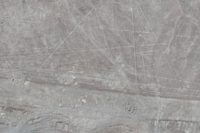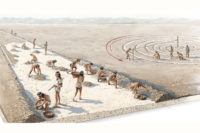 Peruvian archaeologists have discovered more than 50 new ancient geoglyphs in the Palpa province using drone and satellite technology. Known as the Nasca lines after the culture that created some of the largest and most dramatic figures on flat topography so they can only be fully seen from the air, in fact some of the geoglyphs predate the Nasca. The Paracas culture, for example, created elaborate human and animal designs on the sides of cliffs, which makes them visible to people on firm ground, as long as they’re far enough away.
Peruvian archaeologists have discovered more than 50 new ancient geoglyphs in the Palpa province using drone and satellite technology. Known as the Nasca lines after the culture that created some of the largest and most dramatic figures on flat topography so they can only be fully seen from the air, in fact some of the geoglyphs predate the Nasca. The Paracas culture, for example, created elaborate human and animal designs on the sides of cliffs, which makes them visible to people on firm ground, as long as they’re far enough away.
The new geoglyphs add crucial data on the Paracas culture, as well as the mysterious Topará culture, which marked the transition between the Paracas and the Nasca. Centuries before the famous Nasca lines were made, people in the region were experimenting with making massive geoglyphs.
“This means that it is a tradition of over a thousand years that precedes the famous geoglyphs of the Nasca culture, which opens the door to new hypotheses about its function and meaning,” says Peruvian Ministry of Culture archaeologist Johny Isla, the Nasca lines’ chief restorer and protector.
And they’re in need of a most valiant protector. If it’s not truckers driving over the lines, it’s Greenpeace protesters callously treating them like nothing more than a backdrop. The Greenpeace cloud did have a silver lining in that it resulted in a grant from the US government to aid in the conservation of the geoglyphs.
 The additional funding was essential to the new discoveries, because Peru’s archaeological sites are very poorly documented — only 5,000 of the estimated 100,000 have been thoroughly recorded on the ground. Many of them aren’t even accessible to ground teams. The recently discovered ones primarily consist of thin, geometric lines which have been hard-worn by the harsh desert environment. Only the powerful oculi of aerial viewing technology could have detected them. (Boosted by the great repository of knowledge of local peoples who had an awareness of where some of the hillside geoglyphs had been even when they were so eroded they were no longer visible to the naked eye.)
The additional funding was essential to the new discoveries, because Peru’s archaeological sites are very poorly documented — only 5,000 of the estimated 100,000 have been thoroughly recorded on the ground. Many of them aren’t even accessible to ground teams. The recently discovered ones primarily consist of thin, geometric lines which have been hard-worn by the harsh desert environment. Only the powerful oculi of aerial viewing technology could have detected them. (Boosted by the great repository of knowledge of local peoples who had an awareness of where some of the hillside geoglyphs had been even when they were so eroded they were no longer visible to the naked eye.)
Enter the GlobalXplorer project, founded by space archaeologist and 2016 TED Prize recipient Sarah Parcak to marshal the power of crowdsourcing to analyze satellite images for signs of archaeological remains and interference from looters. Parcak and the GlobalXplorer volunteers scoured satellite views of Peru and flagged potential sites of interests. Their data was relayed to Peruvian archaeologists Johnny Isla and Luis Jaime Castillo Butters who, backed by financial support from the National Geographic Society, visited those locations on the ground.
There was little evidence of looters interfering with the sides pinpointed by GlobalXplorer, but there was plenty of evidence of illegal encroachment from abusive, unauthorized gold mining. It was drone footage that broke it all wide open.
How could so many geoglyphs hide in plain sight? Over time, many of the lines and figures have been reduced to faint depressions in the soil, visible only on 3-D scans of the terrain captured by the eagle-eye perspective provided by drones. And despite satellites’ awe-inspiring surveillance power, they can’t see everything.
The most powerful satellite that GlobalXplorer uses can see a foot-wide object from 383 miles above Earth’s surface. That’s the equivalent of seeing a single human hair from more than 650 feet away. But the lines that trace the newfound geoglyphs are mere inches across—too fine to spot from space.
Low-flying drones operating at altitudes of 200 feet or less, in contrast, can spot objects less than a half-inch wide. “The [drone camera] resolution is incredibly high,” says Castillo.
He speaks truth. National Geographic broke the story and has some magnificent aerial video of the lines, both the newly discovered ones and ones that haven’t been recorded before from above, taken by the drones.
“only 5,000 of the estimated 100,000 have been thoroughly recorded on the ground.” is an interesting word-choice.